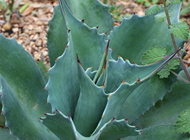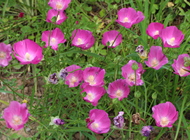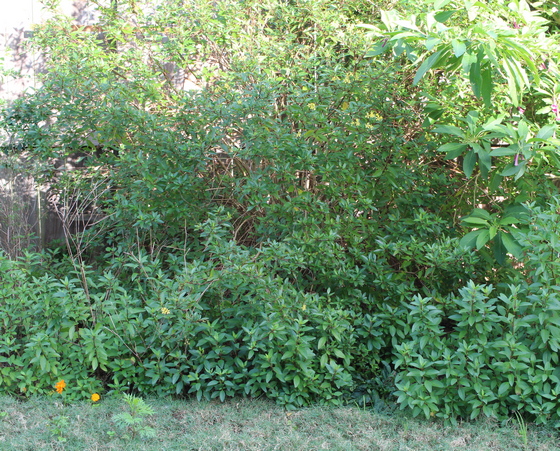 |
Garden journal entry |
 |

Dozens of thryallis seedlings lining up in front of the mama plant |
December 31, 2021. The polar vortex that descended upon Texas in mid-February already seems like an age ago. Although a few woody plants left us completely, many eventually regrew from their roots, so that by now the garden looks almost as full as it did a year ago. That's partly because I adapted my gardening style, allowing many aggressive growers to take up more than their allotted space just to fill in the empty spots left behind by their dead or barely resprouting neighbors. I'll have to take a firmer approach next year, lest I find myself tending to a garden composed primarily of thugs –you hear that, cape honeysuckle and firecracker plant? Meanwhile, the plants themselves have displayed some interesting adaptive responses to the freeze event. While many of the true trees, if they opted to resprout, just did so from right at the base of the old trunk (like the olive tree and the lemon-scented gum), a number of the shrubbier border-dwellers also sent up suckers some distance removed from the mother structure – something they hadn't done in any prior years. I suspect this is a response to the roots receiving no nourishment from the freeze-killed top growth, and pushing up new growth at various points along the root system to start new photosynthesis factories. For example, the Duranta erecta, which had in previous years grown as a somewhat loppy, bushy tree did return from the base, but also sent up suckers in a radius of about two feet around. I now have a nice little crop of baby durantas (some already blooming nicely) that I need to find homes for. Similarly, our star jasmine was killed to the ground and took a long time to push new growth from near the base – but when it did, I also found new jasminelets not too far away. These have likewise thrived.
A different response mechanism appears to have come into play for our thryallis shrub, a star of our back border. It was never quite killed all the way back, and the mother plant was back in full form by late spring. But interestingly, many seedlings sprouted all around its immediate area, which hadn't happened in the previous four years it overwintered in our garden. Could the seeds of this semi-tropical plant actually require a freezing period to germinate? I don't know yet, but I'm experimenting with seeds I collected last fall. So far, they haven't germinated after three weeks at room temperature, so it will be interesting to see whether a week-long trip through the fridge or the freezer (emulating our freezing spell) will entice them to sprout.
Gardening in Pennsylvania, we counted on the rejuvenation of the garden in spring to rekindle our gardening spirit, with nearly everything returning afresh after a winter in hiding. In Houston, where many plants just keep on blooming right through our milder winters, the rejuvenation effect isn't nearly as strong – but it's nice to see that even here, when frigid weather intervenes, nature responds in interesting and (to me) unpredictable ways.
|
Last modified:
September 09, 2009
Contact me
|